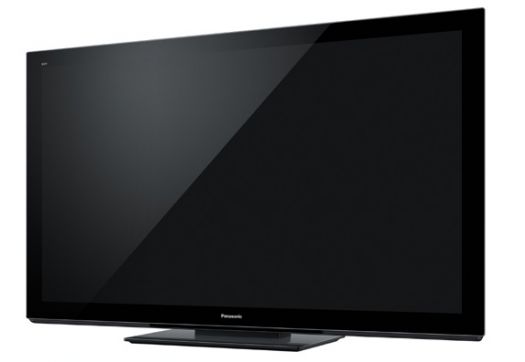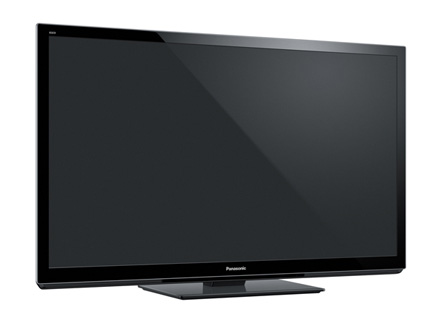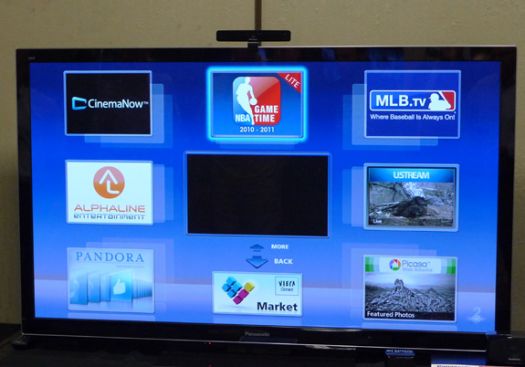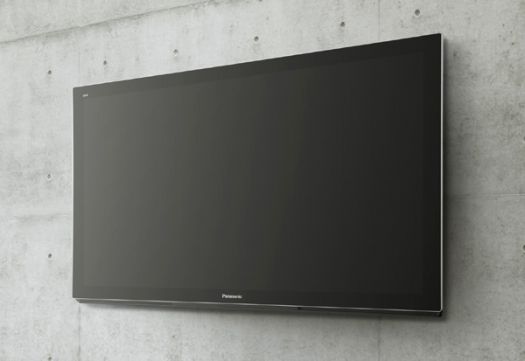At a press event in Los Angeles earlier this week, Panasonic unveiled detailed specs and pricing of their top of the line VT30 and midrange GT30 series of plasma HDTVs and let us get up close and personal with them to see how they performed compared to other plasma and LED/LCD TVs. Panasonic also announced that these sets are now shipping to dealers in sizes up to 65 inches. If the "entry-level" ST30 series of 3D-ready plasma HDTVs is anything to go by, consumers are in for a treat with the entire 2011 line of 3D-ready plasmas from Panasonic. Our own Ian White rated the 50-inch TC-P50ST30 3.5 stars out of 4 for overall performance, usability and value and it earned our coveted BIGGIE Award. You can read more in his TC-P50ST30 review.
Above the ST30 series is the mid line GT30 series and top line VT30 series. Panasonic showed off several models in the GT and VT lines at the event, comparing them not only to competitive LED TV models (both passive and active 3D), but also to Panasonic's own 2010 model TVs. The newest sets showed clear improvements in black levels, motion reproduction and 3D crosstalk, performance areas for which their 2010 plasmas were already well known. Common to all of Panasonic's 1080p plasma models, their new improved neoPlasma panel includes Panasonic's fast-switching phosphors. These phosphors, which make up the picture in a plasma panel, fire and decay faster than earlier panels. This improves motion performance as well as decreasing crosstalk (image ghosting) in 3D mode by ensuring that the image meant for the left eye is not seen by the right eye, and vice versa.

The 2011 models also include better rejection of ambient light with an improved louver filter, as well as an overall 15 percent increase in luminance (brightness) on all of the 3D models. These elements should help the newer sets compare more favorably to LCD and LED models, even on a fairly bright showroom floor. I can tell you that this is the first time I can recall a press briefing with plasma panels where they left the overhead fluorescent lights on during the briefing. And the contrast, color saturation and overall black levels still held up nicely.
Compared to a 2011 LED set with 240 Hz motion processing, the 2011 Panasonic GT30 plasma showed superior motion performance, maintaining subtle picture details even while the image scrolled across the screen fairly quickly. On the LED set, fine details were lost to the motion. And compared to a passive 3D set, the active 3D plasma showed superior detail. This detail advantage was particularly noticeable on diagonal lines which suffered from visible stair-stepping distorition on the passive 3D TV, due to it splitting the 1080p resolution between the left and right eyes. The Panasonic rep also pointed out how standing up too close to one of the passive 3D sets led to a double image with no 3D effect as the vertical viewing axis of passive 3D sets is far narrower than that of a full HD active 3D plasma.
One "enhancement" that has met with mixed reactions from reviewers and other journalists is the inclusion of a new "Cinema Smooth" feature which uses frame interpolation to smooth out the motion of moving objects and camera pans by interpolating intermediate frames in between the existing frames of 24 frame/second film-based material. This technique for smoothing out film motion has been used in LCD and LED sets for years (necessary there in order to prevent motion smearing and blur), but this is the first time we've seen it on a Panasonic plasma. To some, this imparts a "soap opera-like" effect that makes film look more like video, but it can certainly improve the smoothness of a camera pan (for good or ill). Fortunately, although the feature is on by default, on its lowest setting, it can be turned off entirely in the menus.

In terms of overall picture performance, all three lines (ST30, GT30, VT30) feature the new neoPlasma panel with fast-switching phosphors and enhanced luminance levels. In the ST and GT series, it's the "Infinite Black 2" panel. In the VT series, it's the Infinite Black Pro 2 panel, which features an additional treatment to the glass to accentuate black levels. The GT and VT series models are both THX certified in 2D and 3D modes, and the VT30 features ISF calibration settings which can lock in professional calibration modes in custom memories that cannot be easily changed by the end user.
Apps and Calibration and Streaming, Oh My!
Picture performance isn't the only place that Panasonic has made improvements. They've also expanded their previous VIERA Cast suite of internet apps and streaming providers to something called VIERA Connect. In addition to the existing streaming services (such as Netflix, Amazon VOD, YouTube and Pandora, Panasonic has added new streaming services (Hulu Plus is expected to arrive next month) as well as a new third party app development platform, Current apps include things such as online games, health and fitness and sports streaming apps such as NBA Game Time and MLB.TV, both of which require subscriptions in order to view games.

One feature that should appeal to hobbyists and to reviewers like us is the announcement that Panasonic's GT30 and VT30 plasma TVs and DT30 series LED TVs will integrate with CalMan's SpectraCal software for automated calibration of picture elements such as the TV's grey scale. Getting this just right is a sometimes tedious process, even with the right gear. By enabling this process to be automated professional and amateur calibrators can get these settings dialed in much faster. On the plasma TVs, the software allows 10 points of grey scale adjustment. On the LED DT30 series there are 2 points of calibration.
From a style perspective, Panasonic seems to finally be getting the message that people want their flat panel TVs to look good while they're off as well as on. And so we're seeing a subtler, thinner bezel across the model lines as well as a "one sheet of glass" design in the high end VT30 series for a seamless transition from image to bezel.

Cheaper Glasses Right Around the Corner?
Although Panasonic reps were not at liberty to discuss specific details, they did say that news would be forthcoming (perhaps as soon as June) about third generation active shutter 3D glasses that would not only be extremely light, but priced much lower than current Panasonic 3D glasses. How much lower? All they would say is they expect the list price to be "between $50 and $100." Considering Samsung's offering of their basic active 3D eyewear for $50/pair, let's hope for the lower end of that range.
Panasonic 2011 Full HD (1080p) 3D Plasma Model Details:
2011 2D Plasma Model Details:
More Information: